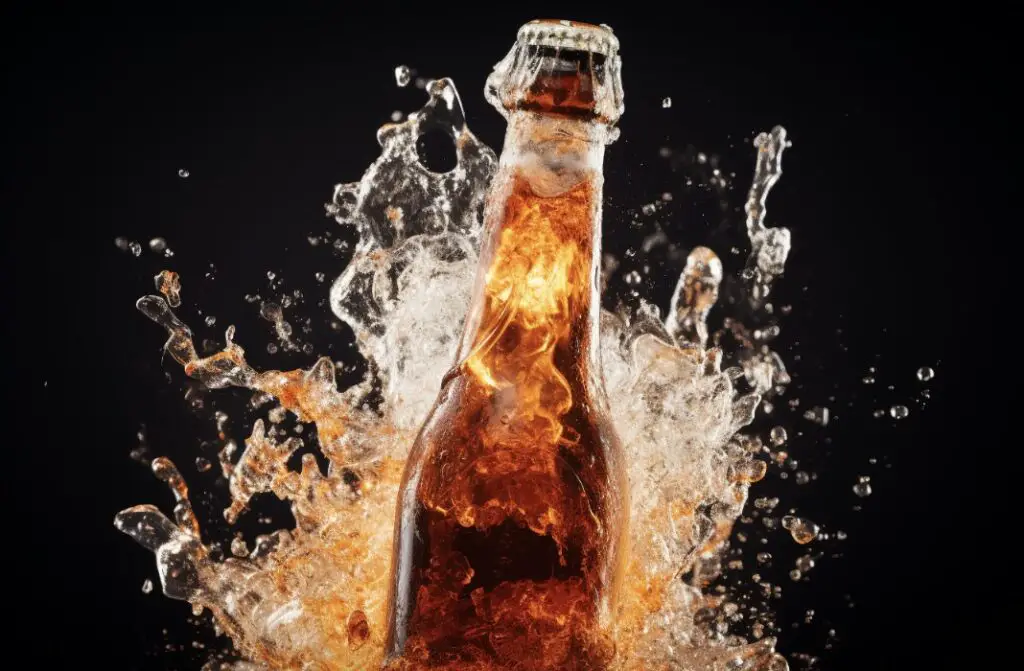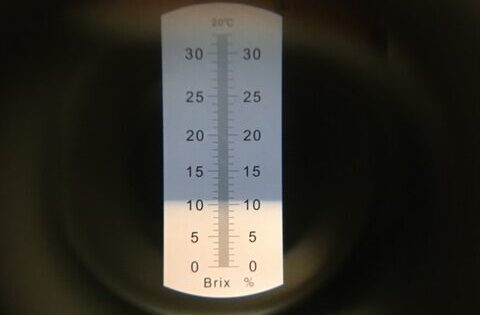Is over carbonated beer bad for you? The short answer is yes, it can be harmful if consumed in excessive amounts.
Over carbonation can lead to an unpleasant drinking experience and, in some cases, cause health issues.
As a homebrewer or a beer enthusiast, it’s essential to understand the causes and effects of overcarbonation and how to avoid it.
In this blog post, we’ll explore the ins and outs of overcarbonation in beer, and I’ll share some personal experiences and tips to help you prevent it.
What is Overcarbonation?
Understanding Carbonation
Carbonation is the process of dissolving carbon dioxide (CO2) in a liquid, such as beer. Carbon dioxide is a natural byproduct of fermentation, and it gives beer its characteristic fizziness and mouthfeel.

The level of carbonation in beer can vary depending on the style, with some beers having a low level of carbonation, like English ales, and others having a higher level, like Belgian tripels or German wheat beers.
The Problem of Overcarbonation
Overcarbonation occurs when there is too much carbon dioxide dissolved in the beer. This can lead to an excessively fizzy, foamy beer that is difficult to pour and enjoy.
Overcarbonated beer can also cause gushing, where the beer foams out of the bottle or can when opened, making a mess and wasting beer.

Overcarbonation can also affect the taste and mouthfeel of the beer. It can make the beer taste overly carbonic and acidic, masking the intended flavors of the beer. It can also create a harsh, prickly mouthfeel that can be unpleasant to drink.
Causes of Overcarbonation
Fermentation Issues
One of the primary causes of overcarbonation is incomplete fermentation. When fermentation is not complete, there will be residual sugars left in the beer, which can cause the beer to continue fermenting in the bottle or can. This continued fermentation produces additional CO2, leading to overcarbonation.
Priming Sugar Errors
Another common cause of overcarbonation is adding too much priming sugar during the bottling process.

Priming sugar is added to the beer to create natural carbonation during bottle conditioning. If too much sugar is added, the yeast will produce more CO2 than necessary, resulting in an overcarbonated beer.
Always calculate exactly how much priming sugar you need to add for your specific type of beer. I have made a priming sugar calculator that takes temperature and sugar type into account.
Infection
In some cases, overcarbonation can be a sign of bacterial or wild yeast infection in the beer. These microorganisms can consume sugars that brewing yeast cannot, leading to excess CO2 production and overcarbonation.
Health Risks of Overcarbonated Beer
Consuming overcarbonated beer can lead to several health issues, especially if consumed in large amounts.

Some of these risks include:
Gastrointestinal Issues
The excess carbon dioxide in overcarbonated beer can cause bloating, gas, and stomach discomfort. In extreme cases, it can lead to more severe gastrointestinal issues like acid reflux or stomach ulcers.
Tooth Enamel Erosion
The increased acidity in overcarbonated beer can erode tooth enamel over time, leading to tooth sensitivity and an increased risk of cavities.
How to Avoid Overcarbonation
Monitor Fermentation
To prevent overcarbonation, it’s crucial to ensure that fermentation is complete before bottling or canning your beer. Use a hydrometer or refractometer to measure the specific gravity of your beer, and ensure that it has reached the expected final gravity.
Measure Priming Sugar Accurately
When adding priming sugar to your beer, measure the amount accurately to avoid adding too much. Use a reliable scale to weigh the sugar, and double-check your calculations to ensure you’re adding the correct amount.

Practice Good Sanitation
Maintaining proper sanitation during the brewing process is essential to prevent infection, which can lead to overcarbonation. Clean and sanitize all brewing equipment, and be mindful of potential sources of contamination, such as wild yeast or bacteria.
How do you deal with over carbonated beer?
If you have brewed over-carbonated beer yourself and is in danger of foam explosions when opening a bottle, there are a few thing you can do:
1. Release excess carbonation: Carefully open the bottle or keg to release some of the built-up pressure. Be cautious to avoid excessive foaming or spillage.
2. Refrigerate the beer: Lowering the temperature can help reduce carbonation levels. Keep the beer in the refrigerator for a while to allow the excess carbon dioxide to dissolve back into the liquid.
3. Vent and reseal: If the beer is in a keg, you can try venting the pressure by slowly opening the relief valve until the hissing sound stops. Then, reseal the keg tightly. Repeat this process if necessary.
4. Pour with care: When serving the beer, pour it slowly and at an angle into a glass. This gentle pour will help minimize excessive foam and release some of the carbonation.
It’s important to note that these steps may not completely eliminate the excess carbonation, but they can help manage the issue to some extent.
Detecting Overcarbonation Before It’s Too Late
The Squeeze Test
One way to detect overcarbonation before opening a bottle is by performing the squeeze test. Gently squeeze a plastic bottle of beer; if it feels hard or has little give, it may be overcarbonated. This method only works for plastic bottles, not glass or cans.
Opening a Test Bottle
If you’re unsure about the carbonation level of your beer, you can open a test bottle to check for overcarbonation. Be prepared for potential gushing and be ready to clean up any mess.
Conclusion
Overcarbonated beer can be unpleasant to drink and, in some cases, harmful to your health. To avoid overcarbonation, ensure that fermentation is complete, measure priming sugar accurately, and practice good sanitation during the brewing process. Keep an eye out for signs of overcarbonation, and take steps to address the issue if it arises.
Here are 10 facts about overcarbonation in beer:
1. Overcarbonation is caused by too much carbon dioxide dissolved in the beer.
2. It can lead to excessive fizziness, foaming, and gushing.
3. Overcarbonated beer can taste overly carbonic and acidic.
4. Incomplete fermentation, excess priming sugar, and infection are common causes of overcarbonation.
5. Consuming overcarbonated beer can cause bloating, gas, and stomach discomfort.
6. The increased acidity in overcarbonated beer can erode tooth enamel.
7. Ensuring complete fermentation and measuring priming sugar accurately can help prevent overcarbonation.
8. Proper sanitation during the brewing process is crucial to avoid infection and overcarbonation.
9. The squeeze test can be used to detect overcarbonation in plastic bottles.
10. Opening a test bottle can help identify overcarbonation issues before serving the beer to others.
FAQs
How do you open overcarbonated beer?
To open overcarbonated beer, it’s important to handle it carefully to prevent excessive foam or spillage. Follow these steps:
1. Chill the beer: Place the overcarbonated beer in a refrigerator for a few hours. Colder temperatures help to reduce the pressure inside the bottle.
2. Release pressure slowly: Gently loosen the cap or cork to release some pressure. Be cautious as the beer may still be highly carbonated.
3. Gradually release carbonation: Tilt the bottle at a slight angle and slowly open the cap or cork a little further. Allow the excess carbonation to escape gradually. Repeat this process until the pressure has been released.
4. Pour with care: Once the pressure has been reduced, pour the beer slowly into a glass, tilting it at an angle. This will help minimize foam formation and prevent overflow.
Remember, opening an overcarbonated beer requires patience and caution.
Why is my beer over carbonated?
Over carbonation in beer can occur due to a few reasons. It could be caused by excessive priming sugar during the bottling process, incomplete fermentation, or a bacterial infection. It’s important to ensure that you are using the correct amount of priming sugar and allowing enough time for fermentation to complete before bottling. Proper sanitation practices and careful attention to temperature control during fermentation can also help prevent bacterial infections.
How do you Decarbonate beer?
To decarbonate beer, you can follow these steps:
1. Pour the beer into a glass or container with a wide opening to allow for faster decarbonation.
2. Stir the beer gently with a spoon or a stirring rod to release the carbon dioxide gas.
3. Alternatively, you can shake the container vigorously for a few seconds to speed up the process.
4. Let the beer sit undisturbed for a few minutes to allow the carbonation to escape.
5. If you prefer a completely decarbonated beer, cover the container with a lid or plastic wrap and refrigerate it overnight. The extended time will help release more carbonation.
6. After decarbonation, the beer may appear slightly flat, so consider serving it chilled to enhance the taste.
Remember that decarbonating beer will alter its intended characteristics, so it’s essential to assess whether this process aligns with your preferences.
How do you fix overcarbonated beer?
To fix overcarbonated beer, you can try a few methods. One approach is to gently release the excess carbonation by slowly and partially opening the bottle or keg, allowing the gas to escape. Another method is to transfer the beer to a larger container, such as a keg or another bottle, to provide more headspace for the carbonation to dissipate. Additionally, chilling the beer can help reduce carbonation levels. It’s essential to be cautious while attempting these methods as excessive agitation can lead to foaming or even loss of the beer.
How do you reduce fizz in beer?
To reduce fizz in beer, there are a few key factors to consider. First, ensure proper fermentation by allowing sufficient time for the beer to ferment and carbonate. This will help prevent excessive carbonation. Additionally, be cautious with priming sugar or carbonation drops during bottling, as adding too much can lead to over-carbonation. Proper storage at the correct temperature is also crucial, as warmer temperatures can cause excess carbon dioxide to be released. Finally, when pouring the beer, use a clean glass and pour slowly at an angle to minimize agitation and excessive foam.




